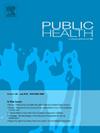Neighborhood characteristics and health literacy: Evidence from the survey of racism and public health
IF 3.9
3区 医学
Q1 PUBLIC, ENVIRONMENTAL & OCCUPATIONAL HEALTH
引用次数: 0
Abstract
Objectives
Limited research exists on the relationship between neighborhood characteristics and health literacy. We investigated the potential impacts of neighborhood characteristics on health literacy and explored whether these associations varied across racial/ethnic groups.
Study design
The study was a web-based cross-sectional study of adults (18+ years old) residing in areas within the US Health and Human Services Regions 1, 2, or 3.
Methods
The 2023 Survey of Racism and Public Health dataset was linked with the 2017–2021 American Community Survey dataset using the respondents' zip codes to obtain measures of residential segregation, neighborhood deprivation, racial and economic polarization, and racial and educational isolation. The Brief Health Literacy Screen was used to assess participants' health literacy. Unadjusted and adjusted models were employed to explore the associations between neighborhood characteristics and limited health literacy.
Results
Of 4948 participants, the mean age was 47 (SD = 17) years, 48 % were White, and 42 % had college degrees or higher. Greater neighborhood deprivation was associated with an increased likelihood of limited health literacy (aOR = 1.12, 95 % CI: 1.01, 1.24). Higher racial and economic polarization was associated with decreased odds of limited health literacy (aOR = 0.83, 95 % CI: 0.73, 0.93). Increased racial isolation is associated with increased odds of limited health literacy (aOR = 1.31, 95 % CI:1.14,1.50). These associations did not significantly vary by racialized/ethnic groups.
Conclusions
Incorporating neighborhood characteristics in health literacy research helps reveal a possible critical key risk factor; higher neighborhood deprivation increases the likelihood of limited health literacy with no variation across the racial/ethnic groups within the same neighborhood. The findings point policymakers toward the direction for intervention in policy changes that will reduce the maldistribution of health—and economic-promoting resources and risky life-course exposures in communities to improve public health literacy.
社区特征和健康素养:来自种族主义和公共卫生调查的证据
目的社区特征与健康素养之间的关系研究有限。我们调查了社区特征对健康素养的潜在影响,并探讨了这些关联是否在种族/民族群体中有所不同。研究设计:本研究是一项基于网络的横断面研究,研究对象为居住在美国卫生与公众服务部1、2或3区的成年人(18岁以上)。方法使用受访者的邮政编码将2023年种族主义和公共卫生调查数据集与2017-2021年美国社区调查数据集联系起来,以获得居住隔离,邻里剥夺,种族和经济两极分化以及种族和教育隔离的措施。简要健康素养筛查用于评估参与者的健康素养。采用未调整和调整模型探讨社区特征与有限健康素养之间的关系。结果4948名参与者的平均年龄为47岁(SD = 17), 48%为白人,42%具有大学及以上学历。社区剥夺程度越高,健康素养受限的可能性越高(aOR = 1.12, 95% CI: 1.01, 1.24)。较高的种族和经济极化与有限健康素养的几率降低相关(aOR = 0.83, 95% CI: 0.73, 0.93)。种族隔离的增加与有限健康素养的几率增加相关(aOR = 1.31, 95% CI:1.14,1.50)。这些关联在种族/民族群体中没有显著差异。结论将社区特征纳入健康素养研究有助于揭示可能的关键危险因素;较高的邻里剥夺增加了健康素养有限的可能性,同一社区内不同种族/族裔群体之间没有差异。研究结果为政策制定者指明了干预政策变化的方向,这些政策变化将减少健康和经济促进资源的不公平分配以及社区中有风险的生命过程暴露,从而提高公众卫生素养。
本文章由计算机程序翻译,如有差异,请以英文原文为准。
求助全文
约1分钟内获得全文
求助全文
来源期刊

Public Health
医学-公共卫生、环境卫生与职业卫生
CiteScore
7.60
自引率
0.00%
发文量
280
审稿时长
37 days
期刊介绍:
Public Health is an international, multidisciplinary peer-reviewed journal. It publishes original papers, reviews and short reports on all aspects of the science, philosophy, and practice of public health.
 求助内容:
求助内容: 应助结果提醒方式:
应助结果提醒方式:


